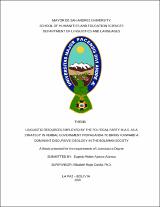Mostrar el registro sencillo del ítem
Linguistic resources employed by the political party M.A.S. as a strategy in verbal government propaganda to bring forward a dominant discursive ideology in the Bolivian society
| dc.contributor.advisor | Rojas Candia, Elizabeth, tutora | |
| dc.contributor.author | Ajoruro Alanoca, Eugenio Walter | |
| dc.date.accessioned | 2021-04-13T14:39:13Z | |
| dc.date.available | 2021-04-13T14:39:13Z | |
| dc.date.issued | 2020 | |
| dc.identifier.uri | http://repositorio.umsa.bo/xmlui/handle/123456789/24942 | |
| dc.description.abstract | This research aims to examine five government propaganda developed by the Ministry of Communication in July and August 2017 in Bolivia. The analysis is focused on Fairclough’s (1995) model of Critical Discourse Analysis, contending that there is a close link across text, discourse practice, and socio-cultural practice. It also employs Walton´s (1997) observation of Propaganda by using Discourse Analysis as a method which claims that propaganda is an art of persuasion and re-education of the audience, even of manipulating the social attitude encouraged by specific objectives. Likewise, the research analysis takes van Dijk´s (1998) ideological structures, which, according to him, are being developed to legitimate power or social inequality. The main objective of this study is to analyze linguistic resources in propaganda employed by the government party Movimiento Al Socialismo (MAS) as a strategy to raise dominant discursive ideology in the Bolivian society. Thus, the present study applies the theory and method of Critical Discourse Analysis (CDA) to examine the ideological components of government propaganda reflected in language. Furthermore, the study is carried out based on a qualitative method to understand how linguistic forms contribute to expand ideology. As a result of the analysis of linguistic resources employed by the government in propaganda, it was found out that the social persuasion is carried out through lexicalization and transitivity and the use of rhetorical devices. In addition, the sign of authority is confirmed by the structure of modality, active and passive voice. Also, social acceptance is performed through the elements of tone and expressive discourse. Manipulation and intimation are supported by nominalization and ambiguity. Further, the dominant ideology is expressed by means of thematic structure and word references. Likewise, the identity of dominant society is reflected through the use of different headlines in TV spots. Finally, the imposition of the propagandist’s ideology is legitimized through the use of pronouns we, ours. These findings also reflect the constant misinformation of the reality. The thesis concludes that propaganda as a political discourse achieves social persuasion and power legitimation through the use of linguistic resources. | es_ES |
| dc.language.iso | es | es_ES |
| dc.subject | ANÁLISIS CRÍTICO DEL DISCURSO | es_ES |
| dc.subject | RECURSOS LINGUISTICOS | es_ES |
| dc.subject | PROPAGANDA GUBERNAMENTAL | es_ES |
| dc.title | Linguistic resources employed by the political party M.A.S. as a strategy in verbal government propaganda to bring forward a dominant discursive ideology in the Bolivian society | es_ES |
| dc.type | Thesis | es_ES |
| dc.thesisdegreegrantor | Universidad Mayor de San Andres. Facultad de Humanidades y Ciencias de la Educación. Carrera de Lingüística e Idiomas | es_ES |
| dc.thesisdegreename | Licenciada en Lingüística e Idiomas | es_ES |

